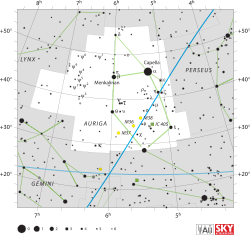Phi Aurigae

| |
| Observation data Epoch J2000 Equinox J2000 | |
|---|---|
| Constellation | Auriga |
| Right ascension | 05h 27m 38.88605s[1] |
| Declination | +34° 28′ 33.2123″[1] |
| Apparent magnitude (V) | 5.089[2] |
| Characteristics | |
| Spectral type | K3 IIIp[3] |
| U−B color index | +1.649[2] |
| B−V color index | +1.411[2] |
| R−I color index | 0.47 |
| Astrometry | |
| Radial velocity (Rv) | +30.78[4] km/s |
| Proper motion (μ) | RA: –1.89[1] mas/yr Dec.: –38.74[1] mas/yr |
| Parallax (π) | 7.20 ± 0.60[1] mas |
| Distance | 450 ± 40 ly (140 ± 10 pc) |
| Details | |
| Radius | 16[5] R☉ |
| Surface gravity (log g) | 1.75[3] cgs |
| Temperature | 4,367[3] K |
| Metallicity [Fe/H] | –0.03[3] dex |
| Rotational velocity (v sin i) | 1.6[6] km/s |
| Other designations | |
Phi Aurigae (φ Aur, φ Aurigae) is the Bayer designation for a star in the northern constellation of Auriga. It is faintly visible to the naked eye with an apparent visual magnitude of 5.089.[2] The distance to this star, as determined from parallax measurements, is approximately 450 light-years (140 parsecs) with a 40 light-year margin of error.[1] This is an evolved giant star with a stellar classification of K3 IIIp[3] and an estimated radius equal to 16 times the radius of the Sun. The outer envelope has an effective temperature of 4,367 K,[3] giving it the cool orange-hued glow of a K-type star.
References
- 1 2 3 4 5 6 van Leeuwen, Floor (November 2007), "Validation of the new Hipparcos reduction", Astronomy and Astrophysics, 474 (2): 653–664, arXiv:0708.1752v1
 , Bibcode:2007A&A...474..653V, doi:10.1051/0004-6361:20078357. Note: see VizieR catalogue I/311.
, Bibcode:2007A&A...474..653V, doi:10.1051/0004-6361:20078357. Note: see VizieR catalogue I/311. - 1 2 3 4 Jennens, P. A.; Helfer, H. L. (September 1975), "A new photometric metal abundance and luminosity calibration for field G and K giants.", Monthly Notices of the Royal Astronomical Society, 172: 667–679, Bibcode:1975MNRAS.172..667J, doi:10.1093/mnras/172.3.667.
- 1 2 3 4 5 6 Cenarro, A. J.; et al. (January 2007), "Medium-resolution Isaac Newton Telescope library of empirical spectra - II. The stellar atmospheric parameters", Monthly Notices of the Royal Astronomical Society, 374 (2): 664–690, arXiv:astro-ph/0611618
 , Bibcode:2007MNRAS.374..664C, doi:10.1111/j.1365-2966.2006.11196.x.
, Bibcode:2007MNRAS.374..664C, doi:10.1111/j.1365-2966.2006.11196.x. - ↑ Famaey, B.; et al. (January 2005), "Local kinematics of K and M giants from CORAVEL/Hipparcos/Tycho-2 data. Revisiting the concept of superclusters", Astronomy and Astrophysics, 430 (1): 165–186, arXiv:astro-ph/0409579
 , Bibcode:2005A&A...430..165F, doi:10.1051/0004-6361:20041272.
, Bibcode:2005A&A...430..165F, doi:10.1051/0004-6361:20041272. - ↑ Pasinetti Fracassini, L. E.; et al. (February 2001), "Catalogue of Apparent Diameters and Absolute Radii of Stars (CADARS) - Third edition - Comments and statistics", Astronomy and Astrophysics, 367: 521–524, arXiv:astro-ph/0012289
 , Bibcode:2001A&A...367..521P, doi:10.1051/0004-6361:20000451.
, Bibcode:2001A&A...367..521P, doi:10.1051/0004-6361:20000451. - ↑ De Medeiros, J. R.; et al. (November 2000), "Rotation and lithium in single giant stars", Astronomy and Astrophysics, 363: 239–243, arXiv:astro-ph/0010273
 , Bibcode:2000A&A...363..239D.
, Bibcode:2000A&A...363..239D. - ↑ "phi Aur -- Star in double system", SIMBAD Astronomical Database, Centre de Données astronomiques de Strasbourg, retrieved 2012-08-23.
External links
This article is issued from Wikipedia - version of the 4/16/2016. The text is available under the Creative Commons Attribution/Share Alike but additional terms may apply for the media files.